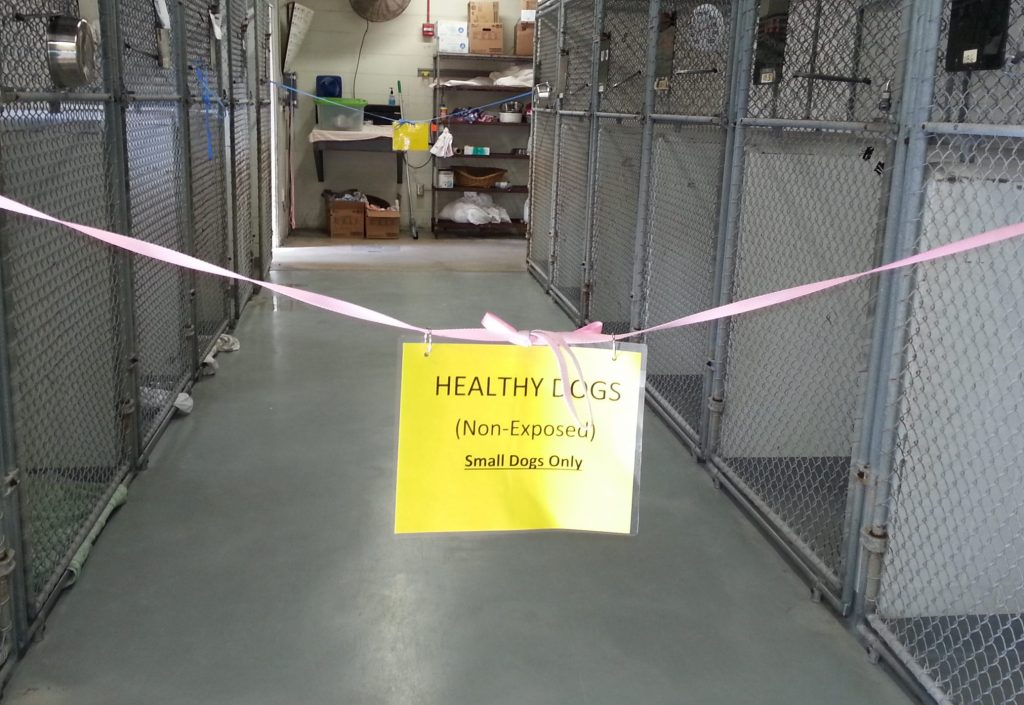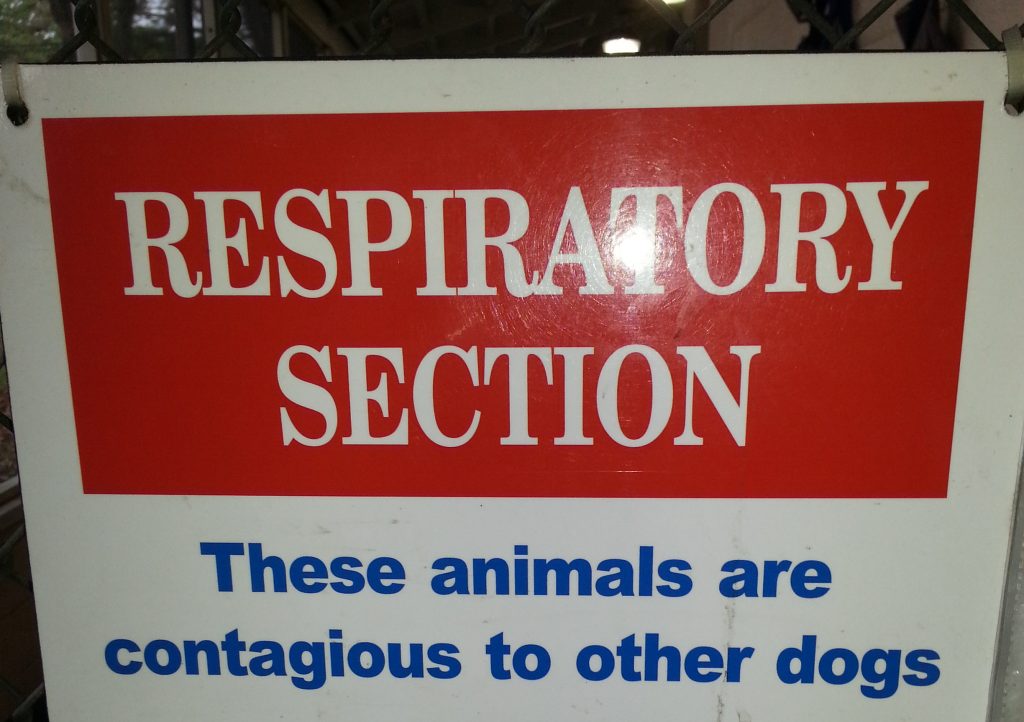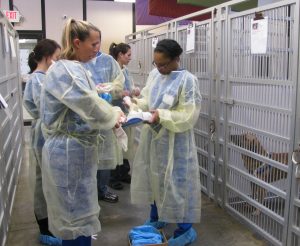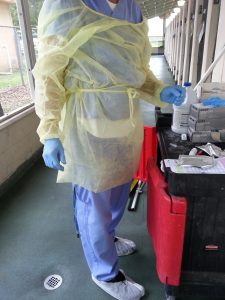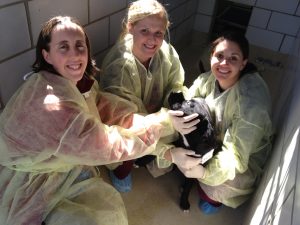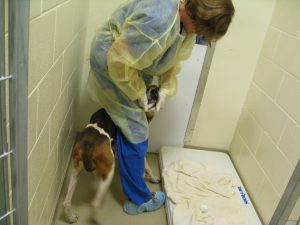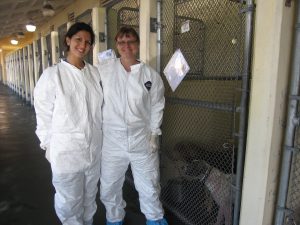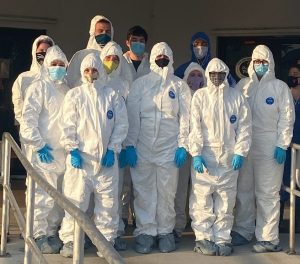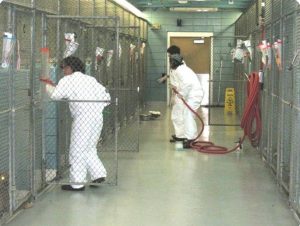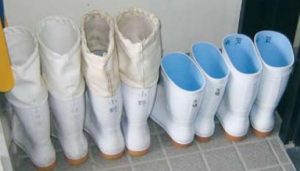Module 5: Management and Prevention of Disease Outbreaks
Biosecurity and Environmental Decontamination
Biosecurity and effective sanitation should be practiced at all times, but is paramount during a disease outbreak. Signage should be placed on entrances to the isolation room, quarantine room, and clean rooms indicating what animals are in the room, no movement of animals in or out, and what staff can enter.
-
Clean housing area designation
-
Isolation ward notice for dogs with respiratory infections
Visibility is enhanced by color-coding the rooms using stoplight colors:

- Red (stop) = isolation
- Yellow ( caution)= quarantine
- Green (go) = clean/unexposed
All animal care supplies can be similarly color-coded and dedicated to each area with no movement of supplies between rooms. Ideally, dedicated staff should be assigned to each room and can wear color-coded badges to match their room assignment to ensure accountability.
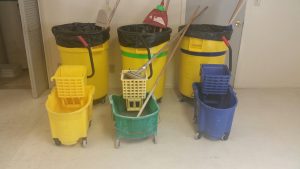
Test Your Knowledge
If there is not enough shelter staff to dedicate to care of animals in isolation or quarantine or in the clean/unexposed room, what is the correct order of care to reduce risk for spread of disease by staff? Match (drag and drop) the room to the correct order of first, second, or third to enter.
When caring for dogs in quarantine and isolation for respiratory and parvovirus infections, staff must wear PPE consisting of full-length Tyvek suits or scrubs that completely cover arms and legs, hair cover for long hair, disposable booties that cover the entire foot or rubber boots, and gloves. This full coverage PPE is also appropriate for staff caring for cats in ringworm isolation.
Disposable yellow gowns and shoe covers placed on street shoes do not protect the lower legs, back, or entire foot. In addition, the yellow gowns consist of a mesh that is pervious to airborne pathogens and contaminated liquids. These items are not appropriate for wearing in dog isolation and quarantine housing or in cat ringworm isolation. However, the yellow gowns and shoe covers are fine for staff caring for cats housed in cages in an isolation or quarantine rooms as long as the cats are not allowed to roam on the room floor.
Studies have shown that footbaths are ineffective and no substitute for using protection that covers the entire foot.
Staff should not enter quarantine or isolation without PPE, even just to run in for a few seconds to grab something, and the PPE should not be worn outside the room.
Here are examples of inappropriate PPE for dog isolation and quarantine rooms. Note the exposure of legs and feet and contact of these unprotected areas with contagious dogs during handling.
-
Improper PPE example 1
-
Improper PPE example 2
-
Improper PPE example 3
-
Improper PPE example 4
Here are examples of proper PPE for dog isolation and quarantine rooms. Note that the Tyvek suits cover the entire leg and arm, and the rubber boots or Tyvek booties protect the entire foot. This prevents contamination of clothing worn underneath. In addition, Tyvek is impervious to airborne pathogens and contaminated liquids. Staff are wearing masks in one of the pictures taken during the pandemic for COVID protection.
-
Proper PPE example 1
-
Proper PPE example 2
-
Proper PPE example 3
-
Communal staff boots for staff working in a dog isolation room
Effective sanitation reduces infectious doses of pathogens in the environment. Disinfectants that kill canine and feline parvovirus and feline calicivirus should be used routinely in all housing areas, not just isolation and quarantine. There are 4 disinfectants that reliably kill these non-enveloped viral pathogens and are safe for use around animals and people. All of these require application to a pre-cleaned surface for full efficacy.
Disinfectants that Kill Parvovirus and Calicivirus
- Household bleach (sodium hypochlorite): 1:32 dilution or 4 oz/gallon
- Wysiwash (calcium hypochlorite): self-diluting when used with the applicator
- Trifectant (potassium peroxymonosulfate): 1%
- Accel/Rescue (accelerated hydrogen peroxide): 1:32 dilution or 4 oz/gallon
These disinfectants should also be used for floors in the housing rooms and for hallways, dishes, litterpans, animal transport or animal control vehicles, transport cages/crates, feral cat traps, and animal handling equipment (leashes, muzzles, catchpoles, catnabbers).
There are 3 disinfectants and dilutions with proven activity against ringworm spores and should be used for cages, equipment, and floors in cat ringworm isolation rooms.
Disinfectants that Kill Ringworm Spores
- Household bleach: 1:32 dilution or 4 oz/gallon
- Trifectant 2%
- Accel/Rescue: 1:16 dilution or 8 oz/gallon
The ASPCA has published a Shelter Disinfectant Quick Reference containing information about the properties and dilutions of commonly used disinfectants.
The spot-cleaning method should be used for routine daily sanitation of cages in all cat housing areas, but is especially important for cats in isolation and quarantine rooms as this significantly reduces risk for spread of infection between cats and contaminated environments.
- Do not remove cats from their cage if the cage is relatively clean. If the cage is dirty, place the cat or kittens in a box or crate that is dedicated to that cage and not re-used for cats in other cages.
- Replace the used litterbox with a new one. Litterboxes in quarantine rooms should not be scooped as the scooper can be contaminated and spread infection from cage to cage.
- Leave bedding in the cage unless soiled. Place soiled bedding in a trash bag for carrying to the laundry room.
- Replace old food and water bowls with fresh ones.
- Wipe down the interior cage surfaces and door with a rag sprayed with Accel/Rescue, bleach, or Trifectant.
- Place old litterboxes and food/water bowls on a cart, not on the floor or countertops. The cart is safest means for transporting these potentially contaminated items to the disinfection station.
- Gloves should be changed between cages in the quarantine room to reduce the chance of spreading virus shed by asymptomatic cats with a subclinical infection or in the preclinical incubation phase of infection.
Test Your Knowledge
It’s a July morning and the shelter is overflowing with kittens. During her morning rounds, the tech finds a dead kitten in a cage with its littermates. This kitten’s littermates appear lethargic and hunched up and the litterbox contains diarrhea. The Idexx CPV antigen test on a sample of the diarrhea confirms feline parvovirus infection or panleukopenia. The litter is moved to an isolation room for treatment and the remaining exposed adult cats and kittens in the main cat room are quarantined. The cats in this room have been in the shelter for <14 days and received only 1 FVRCP vaccine at admission. The only other healthy cat housing area is a group room that contains adult cats that have been in the shelter for more than 3 weeks and received at least 2 FVRCP vaccines. Choose the best answer for the questions below.

